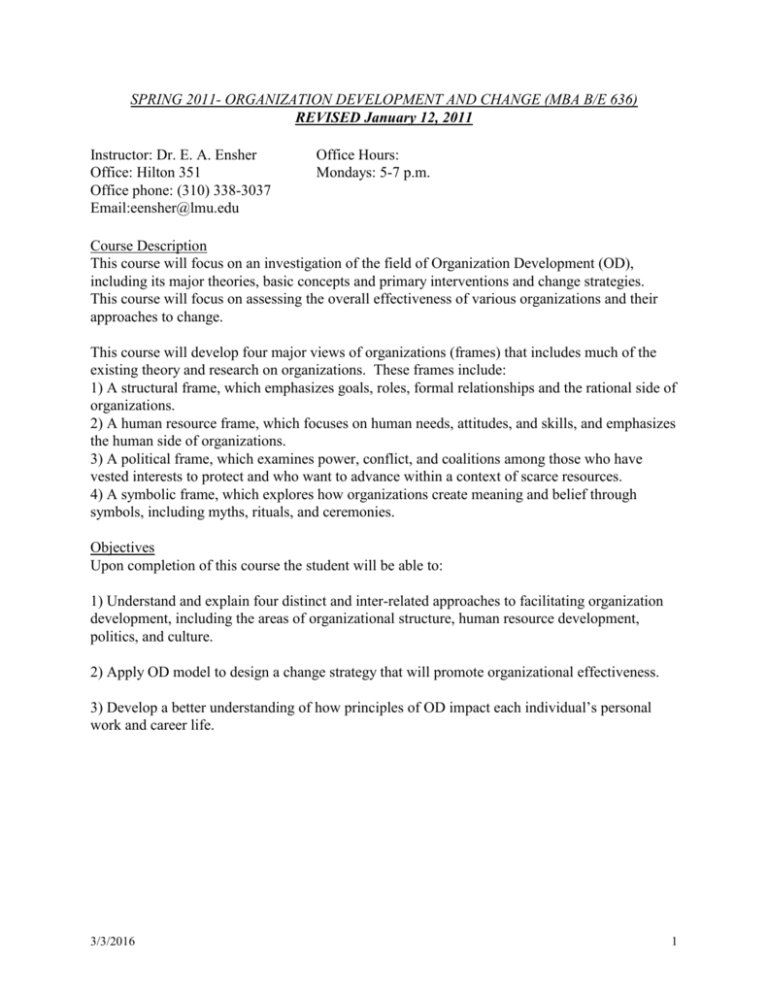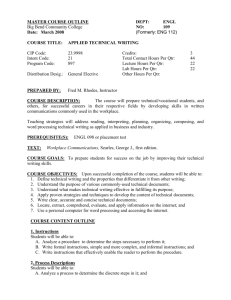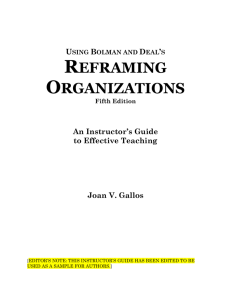ORGANIZATION DEVELOPMENT AND CHANGE
advertisement

SPRING 2011- ORGANIZATION DEVELOPMENT AND CHANGE (MBA B/E 636) REVISED January 12, 2011 Instructor: Dr. E. A. Ensher Office: Hilton 351 Office phone: (310) 338-3037 Email:eensher@lmu.edu Office Hours: Mondays: 5-7 p.m. Course Description This course will focus on an investigation of the field of Organization Development (OD), including its major theories, basic concepts and primary interventions and change strategies. This course will focus on assessing the overall effectiveness of various organizations and their approaches to change. This course will develop four major views of organizations (frames) that includes much of the existing theory and research on organizations. These frames include: 1) A structural frame, which emphasizes goals, roles, formal relationships and the rational side of organizations. 2) A human resource frame, which focuses on human needs, attitudes, and skills, and emphasizes the human side of organizations. 3) A political frame, which examines power, conflict, and coalitions among those who have vested interests to protect and who want to advance within a context of scarce resources. 4) A symbolic frame, which explores how organizations create meaning and belief through symbols, including myths, rituals, and ceremonies. Objectives Upon completion of this course the student will be able to: 1) Understand and explain four distinct and inter-related approaches to facilitating organization development, including the areas of organizational structure, human resource development, politics, and culture. 2) Apply OD model to design a change strategy that will promote organizational effectiveness. 3) Develop a better understanding of how principles of OD impact each individual’s personal work and career life. 3/3/2016 1 Required Readings Reframing Organizations: Artistry, Choice, and Leadership by L. Bolman and T. Deal. (2008), 4th edition. Jossey-Bass Publishers. Organization Development and Change by T. G. Cummings and C. G. Worley. (2009). 9th edition. SouthWestern College Publishing. Organization Development Readings prepared by Mozena Multimedia publishing (www.etext.net) (Available for purchase in class) Requirements 1) You are expected to be fully present and engaged in this class. Specifically, this is a technology and device free zone. Texting, face-booking, twittering or other forms of real-time or electronic distraction are not acceptable during class. I would prefer NO laptops. 2) Readings are required for most classes. Required readings are listed in the syllabus and are to be prepared for the class on the date listed. 3) You will at times be expected to come to class with written answers to questions pertaining to assigned cases, as listed on the syllabus. Quality of your responses will be factored into your class participation grade. 4) Class participation in discussions and activities is critical. Most activities will be held during regular class times, although groups may find a need for additional out-of-class meetings to coordinate their class presentations. Story telling is encouraged, particularly when we discuss the various frames. Consider, relate, and share your personal work experiences as they pertain to class discussions and assignments. 5) Satisfactory attendance (if you must miss a class, it is your responsibility to find out what was missed from a fellow class member- please inform me how this will be handled) 6) Timely completion of course assignments. Late course assignments will be penalized 1/2 grade for every day they are late. 7) This syllabus reflects my expectations of course assignments and standards. From time-to-time however there may be minor changes which will be communicated to you in a timely manner. Grading 1) Personal case study 2) First exam 3) Second exam 4) Chez LMU Team Action case 5) Team OD proposal 6) Group presentation 7) Class participation TOTAL possible 100 points possible 200 points possible 200 points possible 50 points possible 200 points possible 100 points possible 50 points possible 900 points Description of Assignments 1) Individual case study - Provide a 5-6-page description of an incident from your experience, involving a work-related situation (personal case paper guidelines will be provided). If you do not have a work-related situation, please see me for alternatives. 3/3/2016 2 2) Exam I- A set of questions will be provided to you in-class asking you to apply the structural and human resource frames to your personal case study along with discussing the OD process overall. The examination will be distributed in class and you will have the entire class time to complete it. This exam is open book and open notes. 3) Exam II- A set of questions will be provided to you asking you to apply the political and cultural frames to your personal case study as well as questions pertaining to change management and OD as a career. The examination will be distributed in class and you will have the entire class time to complete it. This exam is open book and open notes. 4) Chez LMU Team Action Case- Your team will conduct a brief analysis of an LMU department such as campus food service using the action research OD model. Additional instructions will be provided to you in class. You will be asked to provide a brief 3-4 page synopsis in class. 5) Team OD proposal- The purpose of this 15-20 page paper is to integrate and apply the OD action research model and four frames of organizations to an actual organization that group members have access to, care about, and has evidenced some dysfunctional behavior or has a compelling reason to change or improve. 6) Group presentation- The purpose of this 45-minute presentation is to provide an overview to key learning's from the OD proposal project, provide a demonstration of the frame(s) which were most helpful, and involve class members in an integrative and dynamic group experience. The focus is on interaction and involvement. 7) Class participation - Each class member is expected to come to class having read the assigned material, and be prepared to ask questions, engage in discussion, and participate in simulations and group exercises. 3/3/2016 3 TENTATIVE COURSE SCHEDULE AND ASSIGNMENTS Date Topic Reading Due January 10 Read OD, Chapter 1, Chapter 3 Reader – What’s a Consultant?; January 17 January 24 Course Expectations & Introduction to Organization Development MLK Day- No Class Overview to OD model January 31 Application of OD model OD, Chapter 4; Reader- Flawless Consulting; The Consultants Toolkit -Teams select organization to study for OD proposal February 7 Overview to Reframing -Chez LMU Team Action Case write-up due February 14 Structure frame February 21 Human Resources frame Read Reframing, Chapters 1-2; -Read RFK case (provided in-class prior week) Read Reframing, Ch. 3-4; OD, chapter 14; Reader: The Seven Day Weekend; How Starbucks Changed my life; Latest Starbucks Buzzword (Suggested: OD Ch. 9) Read Reframing, Ch. 6-7; OD 451463. Reader: Power Mentoring; Why Work Sucks February 281 March 7 March 14 No Class Exam I Symbols/Culture Frame March 21 Political Frame March 28 Future of OD April 4 OD and career crossroads April 11 April 18 April 25 Exam II Team Presentations Team Presentations/Wrapup/Evaluation/ Summary May 2 Team OD proposal due in lieu of final exam 1 Assignment Due Read OD, Chapters 2 Reader –How to fix capitalism; Making a do-gooder’ business model work; First Break All the Rules Read Reframing, Ch. 12-13 Reader: Corporate Cults; Zappos culture book, Zappos application; Reframing,Ch. 9-10 Reader: Extraordinary Circumstances; Watch Smartest Guys in the Room on DVD - Personal case study due -Section 1 of Team OD proposal due Bring completed section 3 of action plan for Team proposal to class OD chapter 25; Additional readings may be provided 3/21 Additional readings may be provided on 3-28 Team OD Proposal Due Spring Break Feb. 28-March 4 3/3/2016 4 3/3/2016 5 PERSONAL CASE STUDY The purpose of this assignment is for you to write a case study from your own experience, which you can use as a basis of analysis all semester long. This case study should be fairly meaty and relate a critical incident or series of critical incidents at work which was personally painful, meaningful, or resonated with you in some way. Be sure that this is an organization and incident that you are very familiar with as you will be asked to consider the organization and its players using different conceptual frames. For example, later on in the semester you will be asked to think about the organization structure (how work is organized, who reports to whom), the culture, power and politics, and Human Resource practices. A) To begin, pick a "critical incident or process" that happened to you at work in which you were puzzled or confused or angry or shocked or hurt or extremely happy or proud etc. The key is to choose something that you remember vividly. Write out as much of the detail as you can remember about the critical incident. Include as many of the senses as you can remember including sights, smells, tastes, and textures (if applicable), emotions, conversations etc. B) Next, think of the other key players. Step back and put yourself in their place. Try to describe the critical incident from their perspective. Write out how they might have experience it using vivid description. C) Write the history that led to the event and the history after the event. Then, edit your history to eliminate all but the most important points. The important points should help the class understand "the critical incident" from yours and key players perspectives. D) Decide if you need any exhibits to clarify the case. These might include simplified organizational charts, a copy of a letter or memo (you can disguise confidential information or names), and a diagram of the location. You decide what helps illustrate the case. E) Write an epilogue telling us what actually happened after the critical incident. There are several different alternatives for how you might weave the elements of this case together to make it interesting. Here are some ideas for you to consider. I. 1) You could start off with a conversation where things are heating up. 2) Then, break off to background/history information. 3) Go back to the conversation and finish explaining the critical event. 4) Leave the reader wondering what you will do 5) Write an epilogue telling us what happened. II. You could write it chronologically with as much vivid information as possible, building up to the critical incident. 3/3/2016 6 III. You could write it in a journalistic style and include the following elements: a) who- whose story is it? Who are the other characters?, b) What happened? Include examples of overt and covert action, c) Where did this take place? d) Why do we care? IV. You could write it like a play and include setting, characters, events and let dialogue help reader to understand unfolding action. V. Create your own format. 3/3/2016 7 TEAM OD PROPOSAL ASSIGNMENT Overall purpose The purpose of this assignment is to integrate material learned over the course of the semester and to apply it to an organization that your team cares about. More specifically you will describe how you would apply the 8-step action research model and a 4-frame analysis to recommend relevant OD interventions. Choosing your organization You will have the option of working closely with a non-profit to make a real difference. You will develop a 15-20 page proposal to your client. More detail on these agencies will be provided in class. Your proposal should consist of the following sections: Introduction and History Introduction and brief history to the organization (i.e. several paragraphs) Section 1 Step 1 in action research model is client identifies a problem. Therefore, provide background to problem(s). Provide detail including major players, symptoms of the problem(s) (i.e. turnover is increased, many customer complaints, shooting incident etc.). In this section, you want to briefly review and convince the client that you understand and can describe their pain. What is dysfunctional? Not working? Changing? Why does this organization need an OD consultant? Section 2 Step 2 in action research model is to consult an OD consultant. In this section, provide a brief biography of each team member (i.e. 1 paragraph description for each member). Discuss your assumptions and philosophical approach to OD (hint- this would be a good time to discuss reframing and how it can be helpful). Section 3 Step 3 in action research model is for OD consultant to gather data and make a preliminary diagnosis. Here's where the real work begins! You will need to actually collect data from an organization. Remember, there a number of ways to do this including interviews, surveys, observations, and archival data (i.e. annual reports, published information from media, books written about the organization etc.). Be sure to include information as to why you chose the data collection technique that you did and discuss pros and cons of your choice. Remember, multiple methods are best! You will need to collect as much data as you feel you need to make a good preliminary diagnosis regarding what is going on in this organization. Section 4 Step 4 in the action research model is to provide feedback to the key client or group. This section of the proposal should include a synopsis of the data that you collected. You may use the feedback forms provided in class as samples or create your own format. 3/3/2016 8 Section 5 Step 5 in the action research model is to jointly diagnose problems with the client and step 6 is to jointly action plan for solutions. Assume that you are working jointly with your client (of course, if you can actually do so, than so much the better but I certainly do not expect this!). This is the longest and most challenging part of your proposal. Here is where you need to take the data that you collected, interpret it using the 4-frame approach, and come up with recommendations (i.e. OD interventions) for solving problems. This section will probably be approximately 6-10 pages. I highly recommend that you use sub-headings within this section. For example, you may want to begin by analyzing the organization using each of the 4 frames as a reference. Next, you should discuss what OD interventions or recommendations you would suggest for resolving each of the issues or problems surfaced from your 4-frame analysis (i.e. teambuilding, reengineering, mentoring, job enrichment). Be sure to clarify how and why you think each intervention would be useful. Assume that your client is relatively naive about the various interventions so provide enough explanation that a layperson would understand. Section 6 Step 7 in the action research model is action and implementation. Therefore, in this section provide a preliminary action plan which includes information such as time frame, pros and cons of various interventions, and who would be involved in each intervention. Section 7 Briefly address how you recommend that the client evaluate the efficacy of your recommended approach. 3/3/2016 9







